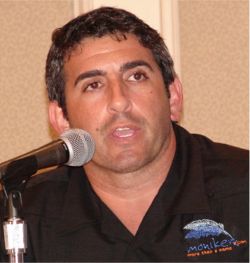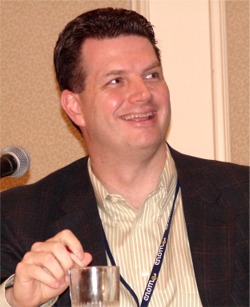|
You
will hear from a blue ribbon group of 20 experts that
include key executives from the leading companies in the
registration, PPC, aftermarket sales, drop catching and domain
development sectors, as well as leading industry attorneys,
trade show organizers and the people whose broad shoulders carry
those mentioned above - domain name owners.
They will give you the specifics, but first let's set the stage. Just
about everyone now recognizes that billions of advertising
dollars have started to migrate from traditional media like
newspapers, radio and TV to the web. In just the first half of 2005,
nearly $4
billion was spent on Internet advertising and that
number is rising rapidly. With that fact fueling the fire, the
past year brought higher domain prices as corporate buyers and
venture capitalists moved into the space in a big way for the
first time, taking competition for top quality domains to a new
level.
Exploding domain values caught the attention of mainstream
media outlets like the Wall Street Journal and Business
2.0 who published articles that have triggered an
unprecedented wave of new interest in domains. Thriving
trade shows like the T.R.A.F.F.I.C. conferences and Domain
Roundtable provided venues for domain owners, investors,
developers and support companies to meet face to face and do deals
that have propelled the industry to heights no one could have
imagined just 15 months ago when such grand scale events did not
exist.
Many
of the top companies in this field have a hand in multiple
sectors, giving their leaders a broad industry view that make them
the perfect point men for this report. We will start with that
group's assessment of the industry at large, then call on VIP's in
the various sectors to get the inside story on what is happening
in every corner of the industry.
|

Monte Cahn
CEO, Moniker.com
|
Moniker.com
CEO Monte Cahn is the ultimate jack of all trades. His company
provides registrar services (including expired name services,
corporate domain management and online brand & domain protection
services through 12 owned and operated ICANN Accredited
registrars), a domain sales aftermarket (DomainSystems.com),
escrow and appraisal services, traffic monetization services (TrafficClub.com)
and hosting services (CoolHandle.com).
Cahn even hosts his own weekly radio show, Domain Masters,
on WebmasterRadio.fm.
2005
left Cahn with many reasons to smile. "On the domain sales
front, our average domain sale price was the highest since 1999
at just over $26,000 per domain sale," Cahn said. |
"Industry wide, the portfolio sale was more common than ever
before. The acquisition trends being set by such companies as Marchex,
Highland Capital, Walnut Ventures, Internet
REIT and the like are now carrying over to smaller
portfolio buyers and sellers."
Cahn
pointed to Marchex's $164 million acquisition of the UltimateSearch/Name
Development portfolio that was finalized in February and the Highland
Capital purchase of a majority interest in BuyDomains.com
as 2005's most significant events in the domain sales arena, along
with several 6 and 7 figure individual domain transactions (some
publicly reported and some not). Moniker handled the domain
transfers in the Marchex deal marking the first time a block
of more than 80,000 names changed ownership at once.
Cahn
said, "As predicted, several registrars attempted to roll
up the market in 2005. Baker Capital acquired Dotster,
which then acquired several other registrars including DotRegistrar.
We acquired 8 registrars and several other organizations such as Enom
and Momentous flooded the market with more than 200 ICANN
accreditations to capitalize on the expired domain and back order
market. This has created a great deal of customer confusion and
frustration with respect to customer support, lack
of consolidation, different management platforms, etc."
"On
a positive note, overall new domain registrations continued to
grow close to 20% over last year," Cahn noted.
"This was partly due to many registrars registering tens of
thousands of domain names to test for traffic, then deleting those
that did not perform within the 5 day grace period so they were
not charged for the registrations. This behavior was frowned on in
the past by Verisign (the central .com/.net registry) but ironically is ignored by
Verisign today because the increased registrations are creating
more revenue and profit for the registry than ever
before...imagine that!"
While .com prices
were rising last year, Cahn also noticed the market was
broadening.
"The continued increase in sales and appreciation
in value of other TLD's and ccTLD's shows a
growing and maturing market in my opinion. 2005 sales activities
are also an indication of domains really being treated like assets
instead of commodities. This will more than likely result in
lending institutions, banks, and other financial facilities
beginning to treat domains like assets based on how they are
performing in monetization and resale values."
|

Dan Warner
COO, Fabulous.com
|
Few
people in any industry know their field as well as does Dan
Warner, the Chief Operating Officer at Dark Blue Sea
and Fabulous.com. His company owns hundreds of thousands of
domains and built a highly acclaimed system to manage them, a
system they also make available to their registration and parking
customers. If you want the real story on what is happening in any
corner of the business, there is no better source.
Warner
began by noting, "In 2005 the remaining generic domains that
were still available for domain mining were finally snapped up.
The result of this push into the generic market has left little
but scraps for anyone looking to mine. The unregistered domains
that remain are largely trademarks, typographical errors,
pseudo-trademarks and nonsensical domains."
|
"The
drop game also became so competitive in 2005 that it became far
less lucrative with many domainers paying over 10 to 20 years
revenue to win the auctions," Warner noted. "The “catch and release” miners
soaked up most of the fringe traffic by registering hundreds of
thousands of domains daily only to drop most of them within the
five day non-penalty period if they didn’t have traffic. Even
this brutish form of registration has largely dried up like a
Japanese fishery."
"However,
as the market has tightened up and the generic domains have become
almost impossible to find it has left more opportunity behind,"
Warner said. "Supply and demand has come into play and it has
forced the market to look towards buying whole domain portfolios
or to heavily compete in the aftermarket for individual or groups
of domains. This has caused domain sale prices to rise sharply.
Prices have climbed beyond those reached during the .com boom and
will continue to rise. Expect that domain prices in 2006 may
double again as the ad revenue continues to build from traffic and
more efficient sales methods are employed."
Warner
said that well financed investors quietly spent tens of millions
of dollars on domains behind closed doors in 2005. However he said
there was a downside too. "After the Marchex transaction some
of the worst portfolios on the market flooded the merchant banks
and advisors to be put up for sale," Warner said. "All
of them claimed to have similar portfolios to the Ultimate Search
deal. They demanded 8 times revenue for portfolios full of
trademark, typo and illicit domains. This had some positive and
negative effects. It forced the merchant banks and financial
advisors to learn about the domain channel and start asking
questions. It also made them realize they had no real
understanding about the domain space. Once the merchant
banks figured out they needed more information to correctly value
these portfolios the consolidation movement was put on hold until
they could be brought up to speed."
Warned
added, "The market has changed. In the early internet boom
domains were largely valued on brand, then traffic was the core
consideration, and now valuation tends to be a combined value of
brand and traffic. Domains now are often sold at retail prices for
emotional buyers and wholesale prices based solely on traffic and
revenue statistics. If someone asks you what the traffic
statistics are on a domain today you know they are a wholesale
buyer looking for a wholesale price. My tip is to buy
wholesale and sell retail."
Looking
ahead, Warner said, "In 2006 the stage has been set. The
merchant banks now understand the domain market a great deal more,
but the problem of valuation and segregation still remains. In
order for consolidation transactions to go forward the investors
need more information about the portfolios. That’s why domain
analytics will become a hot topic this year. Revenue multiples
are not enough, this year buyers want to know metrics and what the
predicted future of the domains they will be buying have. Revenue
today may be gone tomorrow."
| "2006
will be the year of consolidation and truth. Educated buyers are
now in the market and they aren’t going to be buying
yesterday’s fish. They want clean generic domains that have a
strong potential for resale. It really is going to be a Happy New
Year!" Warner concluded.
One
of those large portfolio buyers in 2005 was the InterSearch
Group, a company that spent over $11 million on
portfolios that included gems like IRS.com. Dan
O'Donnell, the CEO at InterSearch, told us the
domain industry enjoyed an ongoing rebirth in 2005 as well as its coming out party in the larger business world. |

|
"It
was exciting to see a significant increase in the amount of
publicity in the mainstream media, attention from Sandhill Road
and Wall Street, in the form of venture capitalists and
increased analyst coverage that brought further legitimacy to our
industry," O'Donnell said.
"Although
the industry is still in it's relative infancy, I do think that
we are entering another stage in the maturation process. This is
attributable to a number of factors, including the
entrepreneurial spirit and endeavor of domainers that has forced
traditional business to take notice, the efforts of industry
leaders to bring participants together to discuss the business at
a global level with events such as T.R.A.F.F.I.C. and a number of high
profile, high dollar deals by publicly traded companies such as
ourselves and Marchex"
"At
InterSearch, 2005 proved to be a pivotal year for us and we enter
2006 extremely bullish on the growth of the space. InterSearch is
a holding company of a number of subsidiaries primarily focused on
technology and specifically internet search. Of those companies,
most of them actively participate in a core channel of the domain
industry. We own a venture fund dedicated to buying domains,
operate ParkingDots, which is a rapidly growing Yahoo!
sponsored domain parking program and manage our own portfolio of
domains, which includes Look.com which we have under
development," O'Donnell noted.
"As
a participant in several sectors of the industry we are very
optimistic assuming that the industry as a whole continually keeps the
advertiser in
mind. In terms of overarching trends in the categories that we
participate in, we see decreased margins, but overall revenue
growth in the parking business, significantly increased yield from
domain portfolios and continued stabilization and rationalization
of domain prices with more transparency and subsequent liquidity."
 |
"Drilling
down a little further into each of those channels, as an
owner/operator with a burgeoning business in the parking channel
we see several trends and innovations taking place, all of which
are good for domainers. A combination of more dynamic pages,
relevant results and improved optimization technology is improving
user experience and subsequently yield from the page."
"We
are seeing the parking business becoming more of a commodity as
more and more players join the space. Those players are all
ultimately controlled and governed by one of the top two PPC
providers (Google and Yahoo!), providing uniform operating rules
and the competition keeps pace with one another in terms of
technology levels, hence the margin compression and
commoditization. We operate from a unique position as a financier
and buyer of domains who operates a top tier parking program.
Subsequently, we embrace this trend and will be differentiating
our parking program in 2006 by moving towards a more transparent
no-haggle pricing model and releasing a variety of exciting domain
leasing programs," O'Donnell said. |
"For
domain owners large and small we see unlimited opportunities.
Parking is one alternative for domainers and their portfolios, but
for higher value domains, the path to building a brand and a
broader business model is eminently feasible and has been proven
out by innovative domain owners large and small with differing
backgrounds and resources at their disposal. We are developing
several domains within our portfolio that have brand potential and
seeing the possibilities first hand ourselves."
"My
optimism is cautioned by the increasing levels of click-fraud and
the industry’s need to address this problem. Google has already
added a CPA component to their PPC product and while there are
certain things in the implementation that I disagree with, I
applaud the overall message that it sends to our community and the
direction that it takes the channel. It is paramount that we
protect the advertiser. By doing that, we will all protect our own
businesses and ensure continued growth for the foreseeable future,"
O'Donnell concluded.
| Sedo.com
CEO Matthew Bentley echoed O'Donnell's emphasis on the
importance of making sure that the interests of those who pay the
bills for everyone - Internet advertisers - are protected. "2005
was the year that domainers recognized that it's not just the
quantity of traffic that counts, but the quality. Although we
still hear people price domains using a multiplier method, for
example, "five times earnings" or "ten times
earnings," in 2006 we're going to see savvy buyers
increasingly asking "a multiple of what?!"
"As advertiser awareness of direct navigation continues to
rise, value will be concentrated in domains that offer an
attractive advertising platform, namely category-owning,
commercially-oriented generic domains - at the expense of domains
where most businesses would not want to see their advertisements, like typos and potential TM domains," Bentley said. |

Matthew
Bentley
CEO, Sedo.com |
"Whereas
the former may begin to fetch multiples of 20-30 years revenue or
even higher, those holding domains less suitable as advertising
platforms will see their sales values shrink to 2-3 years revenue,
or less, as more and more domain professionals wake up to the
reality that it's time for the domain industry to focus on traffic
quality."
"All three of the major domain parking platforms, including
Sedo, have in the past year introduced new initiatives to reward
quality traffic and tighter controls on less quality traffic. At
the moment there may still be smaller parking players willing to
step in and service the junk traffic, but where the leaders go,
the industry will follow. Eventually the time will run out for
those going after the short-term buck, and we'll be left with a
more mature, sustainable industry," Bentley said.
As for his own company, Bentley couldn't have been happier about
developments over the past year. "How was 2005 as a year for
Sedo? In a word, breathtaking! We nearly doubled the number of
domains in our database, adding 1,750,000 new domains for sale.
Sedo welcomed just under 100,000 new members to our global
domainer community, and closed approximately $25 million
worth of domain sales, including some stunners like website.com
for $750,000, annuity.com for $600,000, and recycling.com
for $300,000," Bentley said.
When
we asked Bentley what he saw in the crystal ball for 2006 he told
us, "One
of the premises that Sedo was founded upon is that businesses will
always need a great domain name for their website. This is still
true and will likely remain so for many years to come, providing
an underlying basis to domain values regardless of what happens on
the monetization side of things."
"I sleep better at night knowing
that Sedo has a booming marketplace as well as a leading parking
service. Similarly, domain owners would be wise to build a diverse
portfolio that includes plenty of brandable and resalable domains
in addition to traffic domains, even though it may seem right now
like traffic domain holders are having all the fun. Yes,
that might even mean making some more speculative investments
among the less-saturated TLDs like .info, .biz and the major
ccTLDs (such as .us, .co.uk, and .de). Domainers are investors
now, and portfolio diversification is an essential part of any
investment strategy," Bentley said.
Continue
to Page 2 - Individual Sectors
|



















